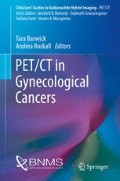Abstract
In recent years, positron emission tomography (PET)/computed tomography (CT) has gained widespread clinical acceptance in oncology. It is being used extensively in the diagnosis, staging, restaging and therapy response evaluation of tumours along with several benign indications in cardiology and neurology. Fluorine-18 (18F) 2-fluoro-2-deoxy-D-glucose (FDG) is the most commonly used positron-emitting radiotracer in PET/CT studies. In this chapter, we will mainly focus on normal variants and artefacts in 18F-FDG PET/CT studies.
The original version of this chapter was revised: The erratum to this chapter is available at DOI 10.1007/978-3-319-29249-6_11
An erratum to this chapter can be found at http://dx.doi.org/10.1007/978-3-319-29249-6_11
Access this chapter
Tax calculation will be finalised at checkout
Purchases are for personal use only
References
Agrawal K, Mittal BR, Bansal D, et al. Role of F-18 FDG PET/CT in assessing bone marrow involvement in pediatric Hodgkin’s lymphoma. Ann Nucl Med. 2013;27(2):146–51.
Mittal BR, Agrawal K. FDG-PET in tuberculosis. Curr Mol Imaging. 2014;3(3):211–5.
Cook GJ, Fogelman I, Maisey MN. Normal physiological and benign pathological variants of 18F-FDG PET scanning: potential for error in interpretation. Semin Nucl Med. 1996;26:308–14.
Cook GJ, Maisey MN, Fogelman I. Normal variants, artefacts and interpretative pitfalls in PET imaging with 18F-fluoro-2-deoxyglucose and carbon-11 methionine. Eur J Nucl Med. 1999;26:1363–78.
Cook GJ, Wegner EA, Fogelman I. Pitfalls and artifacts in 18 FDG PET and PET/CT oncologic imaging. Semin Nucl Med. 2004;34:122–33.
Culverwell AD, Scarsbrook AF, Chowdhury FU. False-positive uptake on 2-[18F]-fluoro-2-deoxy-D-glucose (FDG) positron-emission tomography/computed tomography (PET/CT) in oncological imaging. Clin Radiol. 2011;66:366–82.
Shreve PD, Anzai Y, Wahl RL. Pitfalls in oncologic diagnosis with FDG PET imaging: physiologic and benign variants. Radiographics. 1999;19:61–77.
Delbeke D, Coleman RE, Guiberteau MJ, et al. Procedure guideline for tumour imaging with 18F-FDG PET/CT 1.0. J Nucl Med. 2006;47:885–95.
Boellaard R, O’Doherty MJ, Weber WA, et al. FDG PET and PET/CT: EANM procedure guidelines for tumour PET imaging: version 1.0. Eur J Nucl Med Mol Imaging. 2010;37:181–200.
Segall G, Delbeke D, Stabin MG, et al. SNM practice guideline for sodium 18F-fluoride PET/CT bone scans 1.0. J Nucl Med. 2010;51:1813–20.
Juweid ME, Cheson BD. Positron-emission tomography and assessment of cancer therapy. N Engl J Med. 2006;354:496–507.
Gorospe L, Raman S, Echeveste J, et al. Whole-body PET/CT: spectrum of physiological variants, artifacts and interpretative pitfalls in cancer patients. Nucl Med Commun. 2005;26:671–87.
Shammas A, Lim R, Charron M. Pediatric FDG PET/CT: physiologic uptake, normal variants, and benign conditions. Radiographics. 2009;29:1467–86.
Harisankar CN, Mittal BR, Agrawal KL, et al. Utility of high fat and low carbohydrate diet in suppressing myocardial FDG uptake. J Nucl Cardiol. 2011;18:926–36.
Agrawal K, Weaver J, Ngu R, et al. Clinical significance of patterns of incidental thyroid uptake at (18)F-FDG PET/CT. Clin Radiol. 2015;70(5):536–43.
Corrigan AJ, Schleyer PJ, Cook GJ. Pitfalls and artifacts in the use of PET/CT in oncology imaging. Semin Nucl Med. 2015;45(6):481–99.
Acknowledgements
The authors would like to thanks to Dr Nerriman, Dr Riyamma and Dr Halsey for contributing images for the chapter on PET/CT Imaging: Normal Variants, Pitfalls and Artefacts.
Author information
Authors and Affiliations
Corresponding author
Editor information
Editors and Affiliations
Rights and permissions
Copyright information
© 2016 Springer International Publishing Switzerland
About this chapter
Cite this chapter
Agrawal, K., Gnanasegaran, G., Skoura, E., Corrigan, A., Szyszko, T.A. (2016). 18F-FDG PET/CT Imaging: Normal Variants, Pitfalls and Artefacts. In: Barwick, T., Rockall, A. (eds) PET/CT in Gynecological Cancers. Clinicians’ Guides to Radionuclide Hybrid Imaging(). Springer, Cham. https://doi.org/10.1007/978-3-319-29249-6_8
Download citation
DOI: https://doi.org/10.1007/978-3-319-29249-6_8
Published:
Publisher Name: Springer, Cham
Print ISBN: 978-3-319-29247-2
Online ISBN: 978-3-319-29249-6
eBook Packages: MedicineMedicine (R0)

